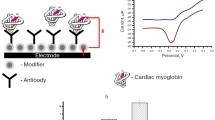Abstract
The most significant goals achieved in the course of the last decade in the design of amperometric biosensors based on redox enzymes entrapped in electrosynthesised polymeric films are reviewed. Particular emphasis is devoted to non-conducting polymers with built-in permselectivity that revealed very promising materials for designing fast-response and interference-free, H2O2 detecting, amperometric biosensors. The role of surface analytical techniques to provide structural information allowing a better understanding of polymers properties and their relationship with the ultimate performance of the final device is also outlined. The most relevant applications of amperometric biosensors based on electropolymerised films to real samples analysis are also reviewed and some possible future trends highlighted.
Similar content being viewed by others
Author information
Authors and Affiliations
Additional information
Received: 12 November 1999 / Revised: 10 January 2000 / Accepted: 16 January 2000
Rights and permissions
About this article
Cite this article
Palmisano, F., Zambonin, P. & Centonze, D. Amperometric biosensors based on electrosynthesised polymeric films. Fresenius J Anal Chem 366, 586–601 (2000). https://doi.org/10.1007/s002160051554
Issue Date:
DOI: https://doi.org/10.1007/s002160051554




